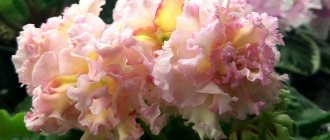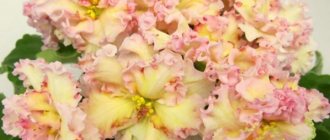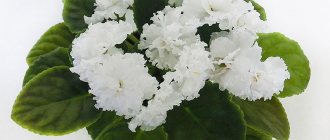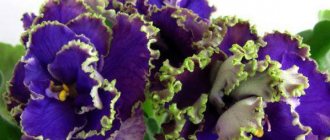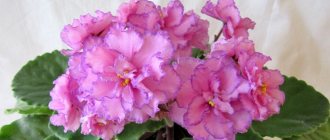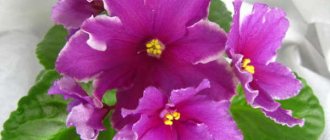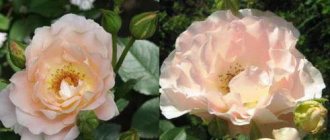The delicate and unpretentious Uzambara violet, having appeared at European flower exhibitions at the end of the 19th century, instantly attracted the attention of flower growers and gave rise to the undying interest of breeders of the Old and New Worlds in transforming its varietal qualities.
Over the years, a huge number of varieties and hybrids of the original tropical plant , and American breeders played a significant role in this.
In the middle of the last century , violet appeared in the collections of Soviet flower growers; domestic amateur violet growers actively participated in the process of its cultivation and made an invaluable contribution to improving the decorative appearance of the charming African guest.
The varieties of violets bred all over the world are conventionally divided into classic ones, found in most gardeners ’ collections, and new ones, recently introduced for sale and in particular demand.
The number of new products is constantly increasing, and previous popular varieties are becoming classics.
At the same time, good-quality classic varieties of violets gradually lose their relevance , being preserved only by the keepers of the variety and its true connoisseurs, and become retro varieties.
They may not be inferior to new products in terms of varietal characteristics and decorativeness, but they are not fashionable breeding objects.
Next, we will show you retro varieties with names and photos of domestic and foreign selection, which are still deservedly popular among violet growers.
Retro varieties of violets
According to an unspoken rule, all varieties of foreign selection obtained in the last century are completely conditionally classified as retro varieties.
IMPORTANT! Domestic varietal violets are classified as retro if they were bred before 1990. Starting from this border, for inexplicable reasons, violets acquire a decorative appearance and a modern perception that differs from retro varieties.
In the Soviet Union, Saintpaulia first appeared in Leningrad - in the Botanical Garden associated with the State University. The first specimens of violets were brought there and its director D.M. Zalessky . The breeding developments of this specialist include the magnificent varieties “Blue Danube” and “Light and Shadow”.
Boris Mikhailovich Makuni , who devoted forty years of his life to delicate violets and created more than 300 of their varieties, is unconditionally recognized as a luminary in the domestic selection of Saintpaulia In order not to divide the breeding line of the Makuni spouses (Boris Mikhailovich worked on varieties together with his wife Tatyana Nikolaevna), who created new Saintpaulias until 2002, all their varieties are considered a retro category.
Boris and Tatyana Makuni.
At the same time as the Master, many domestic breeding enthusiasts worked on the decorative appearance of violets. All of their varieties, created from the late 60s to 19990 and preserved in the collections of flower growers, belong to retro violets.
The reasons for this name
In Soviet times, only passionate non-professional flower growers . They did not know how to keep records and describe the varieties obtained, and did not think about creating catalogs and classifiers.
In this regard , many developments disappeared without a trace, and varieties were preserved in minimal quantities . It is for this reason that their violets are classified as retro.
ATTENTION! In addition, all antiques, household items and decorations that rarely appear in everyday life and carry some historical or material value fall under the term “retro”. This category also includes violet varieties bred from the last century.
Violet Delft Imperial
This variety was bred abroad precisely for this reason and has this foreign name.
Its properties are quite decorative.
It has beautiful green leaves, very bright. The flower is medium size, light blue.
The flowers of Violet Delft Imperial are usually raised above the leaves, this is achieved thanks to the high peduncle.
This violet variety will be an addition to any amateur gardener's collection. There are no particular difficulties in caring for this flower.
Reproduction of Saintpaulia Delft Imperial
To propagate Saintpaulia, leaf cuttings are used. It can be propagated all year round. Cuttings for propagation are cut with a sharp knife or blade four centimeters long.
- Next, they are placed in a jar of water and wait for the first roots to appear.
- They use only settled water, put paper on top of the jar and tie it with thread.
- Holes are made in this paper through which the cuttings are lowered and should touch the water.
- And within three weeks the plants begin to develop roots.
- Afterwards they should be transplanted into pots with the following soil mixture, which should consist of sand, peat and pine soil.
Pots with plants should be placed in a well-lit and warm place and covered with a jar.
For propagation, they also use the method of dividing the uterine bushes. After dividing, they are transplanted into separate pots. The pots are chosen to be small in size. The soil mixture for planting is prepared from pitch, turf, deciduous and humus soil.
Until the plant takes root well, it is watered with warm, well-settled water and periodically fed with fertilizers. Place in well-lit places.
Caring for Saintpaulia Delft Imperial
Saintpaulias are placed in areas of rooms with good lighting, since this is a light-loving flower. The most suitable temperature for growing is twenty degrees Celsius, at this temperature the plant blooms the longest.
For irrigation, use water that is four degrees warmer than the room temperature. When watering, water entering the leaves is unacceptable. When water gets on the leaves of a plant, spots form. Water moderately.
The water should sit for at least a day before watering. In the summer, it makes sense to feed the plant with a solution of cow manure.
The plant is replanted once a year. During replanting, rotten and damaged roots should be removed. The sections are treated with charcoal.
These plants should not be placed in drafts. If little light enters the room, the plant may not bloom. When placing a flower, you should pay attention to ensure that its leaves do not touch various objects, much less other plants.
If it touches other objects, its leaves may rot. Therefore, it is advisable to keep Saintpaulia at a distance from intensively growing plants.
Top varieties of domestic and foreign selection
Domestic selection
In the second half of the 20th century, a whole galaxy of passionate flower growers and self-taught breeders worked on the creation of new varieties of Saintpaulia.
Their names are unknown to a wide circle of violet lovers, but without their dedicated work, the emergence of new modern varieties of this marvelous plant would be difficult. Among them are:
- D.M. Zalessky;
- Makuni spouses;
- V.N. Kolesova;
- S.A. Aksyonova;
- L.V. Radin;
- V.A. Mikheeva;
- I.D. Lowbrow;
- S.I. Prilutskaya and many, many others.
“Beloved Daughter” (B.M. Makuni)
Saintpaulia type standard . Above a dense rosette of slightly wavy leaf blades of a dark green shade, a cloud of lavender color is formed from large corollas of simple fullness.
The petals have a wavy outline outlined in dark purple.
The peculiarity of the violet is the lightening of the color of its flowers as they open.
“Sweetie” (B.M. Makuni)
“Sweetie” is a representative of the Pink Series. Violet standard type.
The rosette with a neat outline consists of leathery, slightly long leaves of a dark tone with a marsh tint. The edge of the sheet is wavy, the reverse side is illuminated in red.
Flowering is cap, almost all year round. The corollas are pink carnations with a greenish fringe on each petal.
“Lilac Fog” (B.M. Makuni)
Standard type. Violet leaves of a dark shade with a rounded-toothed edge form a symmetrical rosette of dense fullness.
The voluminous cap is formed from wavy-corrugated terry-type corollas, colored with transitions of different tones of lilac.
The peculiarity is a very long period of preparation for flowering.
“Solveig’s Song” (B.M. Makuni)
"Solveig's Song" represents the author's Blue Series, being the best in the line . Standard.
An evenly filled, compact rosette is formed by rounded leaves the color of summer grass. Strong flower stalks support magnificent large corollas of a semi-double appearance with a wave along the edges of the petals.
Coloring - shimmering blue tones.
“Blue Danube” (D.M. Zalessky)
One of the first varieties of domestic selection. Standard type.
The neat rosette consists of rounded-toothed leaves with wavy edges, painted in the tone of dark green with an emerald vein. Corollas of simple fullness with a slightly wavy outline.
The buds are painted in a delicate tone of bluish-lilac color.
“Orchid” (V.A. Mikheev)
Based on the type of flower color, Saintpaulia is classified as a two-color violet.
The leaves are greenish-marsh in color with lighter veining and have a rounded shape with a slight point.
The simple-looking corollas are painted with shimmering lilac colors. Along the contour of the flower there is a white edging, turning into a clear pattern on the upper petals.
“Mazepa” (L.V. Radina)
The violet has a somewhat loose rosette due to the elongated leaf petioles. The leaf blades are rounded and light green in color.
The corollas are large in size, terry full.
The peculiarity of the violet is the change in the color of the bud : from a marble pattern in white and lilac tones to a dark lilac color.
“Dark Cherry Shawl” (I.D. Low-bow)
Standard type variety. The rosette is formed dense, with a symmetrical contour .
The leaves have a quilted structure, dark green color and a round configuration with a slight nose.
Flowering in a cap form. The corollas are laid in large sizes, with increased terry, a juicy shade of ripe cherries.
“Miss Moscow” (I.D. Nizkous)
Saintpaulia standard type . With a compact structure, an even rosette of dark green color is assembled from rounded leaf plates with a quilted structure on elongated petioles.
Flowering occurs with the formation of large corollas of terry fullness with waviness at the ends of the petals. The buds are painted with an intense shade of thick pink , reaching a ruby color.
“Rose in the Dust” (S.I. Prilutskaya)
Violet standard type. The medium-sized rosette consists of small-diameter, rounded, wavy-toothed leaf plates the color of lush grass.
It blooms with large terry-type corollas , each petal of which bends in waves. The coloring is distinguished by gentle transitions from white to shades of lilac of varying intensity.
Foreign selection
Flower growers in European countries and America began their developments much earlier than Soviet specialists; the history of their selection is rich in successful discoveries and solutions.
In these countries, entire schools of violet breeding have been established, where they learned in time to classify and describe new varieties.
Good to know! This made it possible to preserve retro violets in a larger volume, indicating the authors and year of creation.
White Madonna (J. Eyerdom) 1953
“White Madonna” was for a long time almost the only variety of violet in the USSR .
An even standard rosette, wavy-jagged leaves of a dark tone, large, terry-type snow-white corollas.
Delft Imperial (J. Eyerdom) – 1962
A classic of breeding developments, a standard type variety.
Symmetrical rosette, dark green leaves with a sharp-toothed edge on light petioles, deep blue corollas with terry fullness .
Neptune (Armacost & Royston) – 1935
Standard with oval-pointed leaves of a lush green color and strong veining. The flowers are simple in appearance , painted in a delicate lilac color with a transition to a thicker shade closer to the center.
The variety is not far removed from natural species.
French Lilac (J. Swift) – 1976
Large standard. The leaves are dark in color with sharp teeth along the edge.
The corollas are terry type, lilac-bell-shaped in color with a lighter edge along the contour of the petals.
Lilian Jarrett (F. Tinari) – 1961
Rounded leaf plates with a pointed end, the color of lush green.
It blooms with double-type corollas in delicate shades of pink.
Varietal violets Morgan's Windorah, PC-Temple of the Sun, Rob's Ruff Stuff and other miniatures.
Dear violet lovers, summer is over... and autumn is already approaching mid-autumn. But my violets continue to bloom and today I want to show you several new varieties from my collection of miniatures and “oldies” that have been with me for a long time.
Violet Morgan's Windorah, Eros:
I came across this variety quite recently. This is the first flowering. It has been blooming for 2 months already. The flowering is very abundant, the peduncles are strong and branched. New flower stalks are constantly appearing.
The flowers are not large, a pleasant pink color, mainly with a green ruffle along the upper petals. The socket is smooth and compact. Very abundant flowering. I liked the variety, I like it when the variety has abundant, long-lasting flowering.
The next new variety is RS-Temple of the Sun, Repkina:
This is the first flowering:
I started this variety because it has gel foliage (I like varieties with unusual foliage).
The rosette is good, even, but it looks like it will be quite large... the flowers are large.
Closer flowers:
The flowers are a soft pink with hints of fantasy in a darker color. The yellow center appears, as I was told, in the second or third flowering. I will watch…
And now I’ll show you the flowering of my old-timers.
Violet Rob's Ruff Stuff, Robinson:
This variety is somehow undeservedly forgotten... I really like it. Ideal rosette, frequent abundant flowering.
Bright pink flowers with fantasy blue and green ruffle:
Violet Peppermint Girl, Pittman:
A wonderful miniature with a beautiful compact rosette of gel leaves similar to oak leaves. Blooms often and abundantly.
Violet Crashed Velvet, Boone:
The flowers are dark burgundy in color, slightly lighter towards the edges of the petals. It is difficult to convey the color in a photo; in reality it is much darker. Flowers on strong peduncles. Flowering is abundant. For good flowering you need long-term intense lighting. A beautiful even rosette of dark green quilted leaves.
Violet Nibble, Sorano:
A distinctive feature of this variety is clacamus foliage and large double pink flowers on long peduncles:
On an adult rosette there can be up to 5 flowers on one peduncle.
The variety is not easy to grow. Often stepson and sometimes bifurcates the crown. It grows rather slowly and does not bloom very often. But I still keep it in my collection for its clacamus foliage and these very large pink flowers with a lilac coating on a compact rosette.
And, of course, Jolly Frills, Pittman:
An ideal variegated rosette. Flowering is frequent and abundant. Grows quickly and blooms early. An ideal variety for beginning collectors. It is not difficult to grow.
In July I showed varieties N-Dubrava and LE-pink Muscat. Almost 5 months have passed since the first flowers bloomed on these rosettes. Now they continue to bloom and do not stop.
N-Dubrava, Berdnikova, photo taken a few days ago:
Violet LE-Pink Muscat, Lebetskaya:
New flower stalks constantly appear on these rosettes and new flowers open. I can’t figure out the right time to transplant them, although it’s time.
Perhaps that’s enough for today, especially since photos are very difficult to load...
There are still a lot of photos in stock, I will try to introduce you to other varieties in the near future.
Dear violet lovers, write, show your violets, share the joy of the first flowering, and not just remember the site when some trouble happens.
Original retro varieties of Saintpaulia
Among the entire variety of violets of the retro group, you can choose the most outstanding varieties for the collection based on various distinctive features:
- according to the color of the corollas - “Echo of the Carnival” (S.I. Prilutskaya);
- according to the shape of the flower - “Lituanica” (F.K. Butene) - the corollas resemble rose flowers in a reduced size;
- according to the doubleness of the flowers and the splendor of the cap - “Your Majesty” (B.M. Makuni);
- by leaf color - “Black Cat” (N.N. Shiryaeva) - variegated violet.
